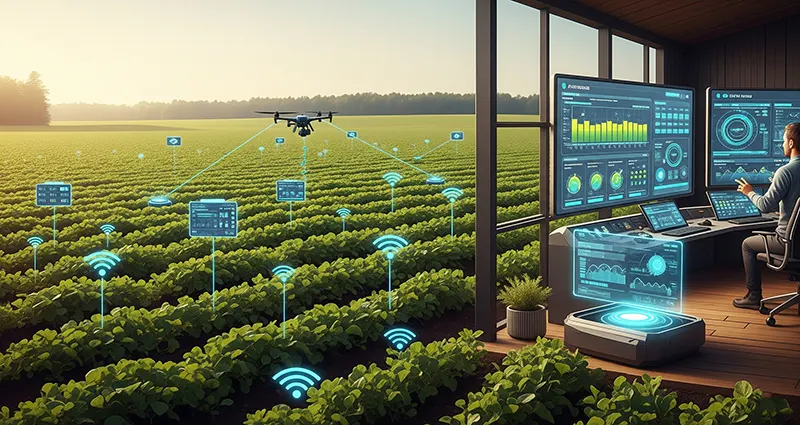The agricultural landscape is undergoing a significant transformation, driven by the integration of cutting-edge technologies. Among these, the Internet of Things (IoT) stands out as a pivotal force, ushering in an era of “precision agriculture” that promises increased efficiency, reduced waste, and enhanced sustainability. At the heart of this revolution lies the ability of IoT devices to provide real-time, granular data for comprehensive crop monitoring, empowering farmers with unprecedented insights into their fields.
What is Precision Agriculture?
Precision agriculture is a data-driven approach that optimizes agricultural inputs and practices to maximize crop yield and minimize resource waste. It moves away from traditional, uniform farming methods, instead tailoring agronomic techniques to the specific needs of individual fields, crops, or even plants. This customization is made possible by the continuous flow of data collected through IoT devices.
Key Applications of IoT in Crop Monitoring:
The applications of IoT in crop monitoring are diverse and impactful, touching upon various aspects of crop management:
- Soil Quality Monitoring: IoT sensors embedded in the soil provide crucial data on parameters such as moisture content, nutrient levels (e.g., nitrogen), pH, and temperature. This real-time information allows farmers to make informed decisions about irrigation schedules, fertilization, and even the selection of appropriate crop types for specific soil conditions. By understanding the precise needs of different areas within a field, farmers can optimize resource allocation, preventing over- or under-application of water and nutrients.
- Crop Health Evaluation: Drones equipped with multispectral, thermal, and visual cameras, along with ground-based sensors, capture detailed images and data about crop health. This allows for early detection of issues like pest infestations, diseases, and nutrient deficiencies. Image processing and AI algorithms analyze these visuals to identify stressed areas, enabling targeted interventions and preventing widespread damage.
- Irrigation Management: IoT-enabled automated irrigation systems utilize soil moisture sensors and weather data to determine the exact amount of water needed for crops. This intelligent approach optimizes water usage, reducing waste and ensuring that plants receive adequate hydration without overwatering.
- Pest and Disease Detection: Beyond visual inspection, IoT solutions can also detect the presence of pests and diseases through various means, including analyzing plant images, environmental conditions, and even sounds. Early detection is critical for timely intervention, minimizing crop loss and the need for broad-spectrum pesticide application.
- Climate Condition Monitoring: Remote sensing through IoT-based weather stations deployed across farms collects data on temperature, humidity, rainfall, and wind speed. This real-time climate data helps farmers anticipate weather changes, plan farming operations, and protect crops from adverse conditions.
- Yield Forecasting and Quality Control: By continuously monitoring crop growth stages, health, and environmental factors, IoT systems can contribute to more accurate yield forecasting. Computer imaging, for instance, provides precise information regarding crop quality, aiding in better post-harvest processing and market planning.
Benefits of IoT in Crop Monitoring:
The adoption of IoT in precision agriculture offers a multitude of benefits:
- Increased Crop Yields: By providing precise data and enabling targeted interventions, IoT helps optimize growing conditions, leading to healthier crops and higher yields. Studies have shown significant increases in yields for various crops with the implementation of precision agriculture.
- Optimized Resource Utilization: IoT minimizes the waste of valuable resources like water, fertilizers, and pesticides by ensuring they are applied only where and when needed. This not only reduces costs for farmers but also lessens the environmental impact of agricultural practices.
- Reduced Labor Costs: Automation of tasks like irrigation and monitoring reduces the need for manual labor, allowing farmers to allocate their workforce more efficiently.
- Enhanced Decision-Making: Real-time data and analytical tools empower farmers with actionable insights, enabling them to make informed and timely decisions regarding all aspects of crop management.
- Improved Environmental Sustainability: By reducing resource consumption and minimizing the use of harmful chemicals, IoT-driven precision agriculture contributes to more environmentally friendly farming practices.
- Increased Resilience: Real-time monitoring and predictive capabilities help farmers respond quickly to challenges like adverse weather or pest outbreaks, making their operations more resilient.
The Future is Connected:
The integration of IoT in precision agriculture is not just a trend; it’s a fundamental shift towards a more efficient, productive, and sustainable food production system. As technology continues to advance, we can expect even more sophisticated IoT solutions to emerge, further enhancing crop monitoring capabilities and ensuring global food security in a changing world.









